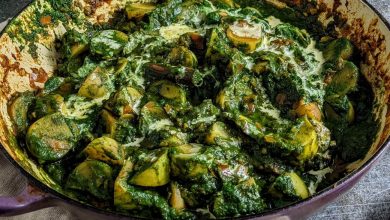Ras El Hanout Recipe (Moroccan Spice Powder)
Ras El Hanout, one of the most cherished and complex spice blends in Moroccan cuisine, is a wonderful addition to your pantry, especially when you’re looking to experiment with African flavors. This spice powder, with its tantalizing aroma and robust taste, elevates a variety of dishes, from meat marinades to tagines, and even makes an incredible dip when whisked into yogurt. The beauty of Ras El Hanout lies in its versatility and depth, which is derived from more than a dozen spices blended together. With a hint of warmth, sweetness, and heat, it is guaranteed to add a unique kick to your culinary creations. Not only is Ras El Hanout a key player in Moroccan cooking, but it’s also incredibly easy to make and store, giving you the freedom to adjust spice levels to suit your personal taste.
Ingredients for Ras El Hanout
| Ingredient | Quantity |
|---|---|
| Cinnamon Stick (Dalchini) | 2 inches |
| Cloves (Laung) | 10 pieces |
| Cardamom (Elaichi) Pods/Seeds | 10 pods/seeds |
| Coriander (Dhania) Seeds | 1 tablespoon |
| Cumin Seeds (Jeera) | 1 tablespoon |
| Paprika Powder | 2 tablespoons |
| Whole Black Peppercorns | 2 teaspoons |
| Turmeric Powder (Haldi) | 1-1/2 teaspoons |
| Mace Powder (or Grated Mace) | 1/2 teaspoon |
| Red Chilli Flakes | 1 teaspoon |
| Nutmeg Powder (Grated) | 1/2 teaspoon |
| Fennel Seeds (Saunf) | 1 tablespoon |
| Dry Ginger Powder | 1 tablespoon |
| Star Anise | 1 teaspoon (grated) |
| Dried Rose Petals (Optional) | A few petals (optional) |
Preparation Time: 15 minutes
Cooking Time: 20 minutes
Instructions
To make your very own Ras El Hanout spice blend, begin by assembling all the spices listed in the ingredients. The key to crafting the perfect Ras El Hanout lies in the roasting process, where each spice is carefully toasted to release its fragrant oils, which bring out its full aromatic potential.
-
Prepare the Spices: In a dry kadai or frying pan, heat it up over medium heat. Add each spice separately and dry roast them individually. The goal is to heat each spice just enough to allow its oils to release, without allowing them to brown or burn. Be sure to handle the spices carefully as they can burn quickly if left unattended.
-
Cool the Spices: Once each spice has been roasted and has released its aroma, immediately remove it from the pan to prevent over-roasting. Allow the spices to cool down completely before moving on to the next step.
-
Blend the Spices: After all the spices have cooled, add them to a high-quality blender or spice grinder. If needed, break down larger pieces, such as the cinnamon stick and star anise, to ensure a uniform blend. Blend until you achieve a fine powder.
-
Store Your Spice Mix: Transfer the freshly blended Ras El Hanout spice powder into a clean, dry, airtight container. The blend will keep its potency and flavor for months when stored properly in a cool, dark place.
Allergen Information
Ras El Hanout is typically free from common allergens such as nuts, dairy, and gluten, making it an ideal spice blend for those following vegetarian or gluten-free diets. However, it’s important to be cautious of any cross-contamination if you’re sensitive to certain spices, especially if they are processed in facilities that handle allergens.
Dietary Preferences
This Moroccan spice blend is suitable for vegetarian diets and can be easily incorporated into vegan meals as well. Ras El Hanout’s versatility means that it can be used in a variety of dishes, including salads, roasted vegetables, meats, and even plant-based alternatives. Its robust flavor profile enhances both simple and complex meals, whether you’re cooking a traditional Moroccan dish or adding a touch of North African flair to your modern kitchen creations.
Tips for Using Ras El Hanout
- Meat Marinade: Ras El Hanout makes a fantastic marinade for meats like chicken, lamb, or beef. Simply mix the spice blend with olive oil, garlic, and a splash of lemon juice for a flavorful coating before grilling or roasting.
- Tagines: The aromatic depth of Ras El Hanout adds complexity to tagines, one of Morocco’s most iconic dishes. Pair it with a variety of vegetables, meats, or even dried fruits to bring out the unique flavors.
- Yogurt Dip: For a simple and delicious dip, whisk some Ras El Hanout into Greek yogurt with a squeeze of lemon and a drizzle of olive oil. This makes for an excellent accompaniment to bread, roasted vegetables, or as a spread for sandwiches.
- Sprinkle Over Salads: Use Ras El Hanout as a finishing touch by sprinkling it over fresh salads. It enhances the flavor of greens and adds an exotic twist to your regular salad dressing.
Conclusion
Ras El Hanout is not just a spice mix; it’s a window into the flavors of Morocco and North Africa. With its intricate combination of spices, it offers a depth and complexity that can elevate almost any dish. Whether you’re a seasoned cook or a beginner, crafting this spice blend at home is easy, and it opens the door to experimenting with a range of exotic recipes. With this Ras El Hanout Recipe, you can bring the flavors of Morocco to your kitchen anytime, and customize the blend to your taste preferences. It’s a pantry essential that adds a unique and vibrant flavor to your culinary creations.





